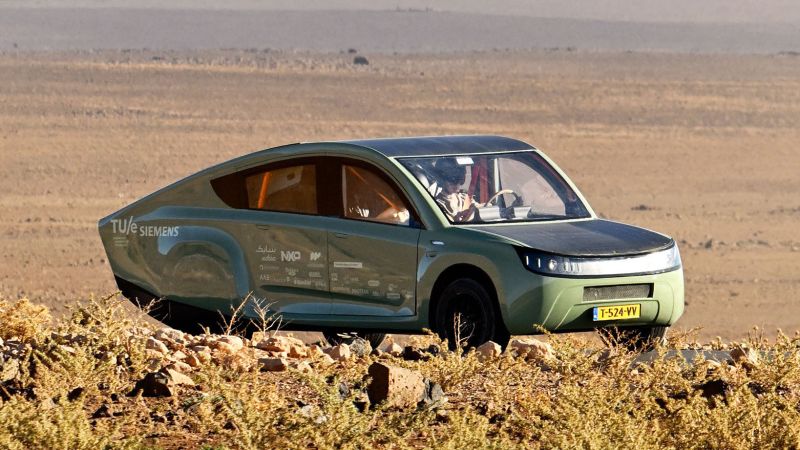Built by a team of students at Eindhoven University of Technology (TUE), “the world’s first off-road solar-powered vehicle” could help connect remote areas “where roads are less developed and energy grids are not as reliable,” and assist with emergency aid and deliveries, says Thieme Bosman, events manager for the team.
The team tested the vehicle in Morocco earlier this month, driving more than 1,000 kilometers (621 miles) between the country’s northern coast and the Sahara Desert in the south.
That’s cool as fuck. I heard about solar powered vehicles years ago, but they weren’t nearly as successful as this one.
Would be pretty funny if parking spots in tge sun were suddenly the desired ones.
This is very cool indeed. I saw some solar racers run through Denver, CO decades ago and they were all tiny, ultra light weight (like a few hundred pounds), very low to the ground (like < 3 ft / 1m tall), and totally impractical.
This is the type of research governments should be investing in. This is awesome.
AND it looks cool.
how fast tho
It says in the article top speed is 90 MPH. For the off-road conditions it’s designed for, speed isn’t the primary goal.
I imagine doing 90mph on a dirt road would feel like the jump to hyperspace. It’s been pretty rare where I’ve had to drive faster than 90mph on the roads myself so this rate of travel would meet my needs even on road.
Top speed is 90 mph with it’s battery. You’re not hitting 90mph on solar power only.
None of the articles I’ve found mention the exact start and end date, but their twitter say they started on the 12th and finished on either the 15 or 16th since that’s when all the articles started popping up. That’s about 150-210 miles a day, and I assume it’s battery was fully charged before they took off which is 440 miles of that range. That’s including them using their solar canopy to help charge the battery, and not just a purely static roof powered car Plus it’s a best case scenario since it was the sunny Moroccan desert and not a city or somewhere with less intense sun.
Solar roof cars (for actually propelling them forward) is mostly a gimmick currently unless we can get some major solar panel tech improvements. There’s just not enough square footage for the panels. They do make sense to run the AC while you’re not in the car without depleting the battery, but outside of that they’re just silly.
If it went 621 miles, and 440 was on battery, that means it went 181 miles on solar. Even if that was 4 days, that’s still 45 miles per day on solar. That is an amazing achievement. That’s enough that most people probably would never need to charge except when taking long trips, and would not just be a gimmick at all.
if roof panels were a pretty cheap addon for electrics it would be a no-brainer but they are probably still too expensive to make a lot of sense. better to just make the rest of the car more efficient.
It has a standard 60 kW-hr battery, so similar to a mid-range EV.
Cool I’ll certainly consider getting one when I next live in fucking NORTH AFRICA. Not so much fucking sun where I am though.
Got Wind?
What’s with the downvotes? I live in the Arctic. It’d be dead weight for much of the year.
Because not every product is designed for every person in every situation. And that’s OK.
Oh, no, the downvotes have nothing to do with where you live yet they have something to do with you being arrogant and ignorant
Would you care to elaborate? I mean I’ve been to Morocco. The sun’s powerful enough to cook flesh. Most people don’t live in the Sahara or the atlas mountains though. The whole reason they tested it there is that it’s the place with the most reliable sunshine. The further north you go, the more cloud cover you get as well as a shallower angle of incidence. The further you deviate from a 90° angle of incidence the less conversion you get. Until you get to the point where it’s all reflected. And the weird folding system of the solar panels in the back of the TWO SEATER SUV means the panels can’t be tilted.
A trailer full of fold out solar panels that can be angled towards the sun, used to charge a normal EV would be a far simpler and less impractical solution.
Also the reason it’s so light is that the motor had to be kept small so that the vehicle could move. It fails as a useful car but definitely fails as an SUV.
Also solar panels deteriorate over time. Are you going to replace the roof of the car every 5 years?
As I am clearly ignorant AF, feel free to walk me through the physics and prove me wrong.
Well see, now you’re actually making good points that do have some value to them.
First and foremost, that a concept built by a bunch of students, it doesn’t have to be perfect, it’s goal is to prove the concept. The first ever built plain that actually worked wasn’t perfect - does that mean people who built it should’ve abandoned it?
Not everything has to be equally viable in all circumstance. Building made in regions with high seismic activity are built in a way to account for that activity. If one lives on a flatland with zero seismic activity - those extra resources spent on a building might seem worthless to such a person, but they are not and if said person says that "they can just build normal houses there, what’s the issue? " then the person is ignorant (and also a complete prick).
As to the car failing as an SUV - I haven’t seen where they driven during the test run so I can’t say whether or not it failed. They got from the point A to the point B so if I had to guess I say it worked fine.
P. S. I’m not sure why I’m wasting my time on this with that attitude of yours with prove me wrong and such… Yeah, whatever







